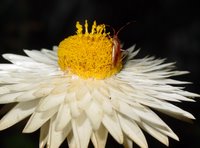
ARACHNIDS
*Shed exoskeleton, possibly of Hololena curta which hangs out in shrubbery and is about this size. OK, not exactly a siting but I like the photo of it festooned on the poinsettia leaves.
*Green lynx, Peucetia viridans spiderlings (many) and adult females (2). These two females still at their nest sites are very shy now, seeking shelter among the web-bound foliage at the slightest poke of a lens.
*Orb weaver spiderling, Neoscona oxacensis (1)
*Cobweb spider, Pholcus phalangioides (numerous)
*Unidentified spiderling looking like a crab spider (1)
*Predatory mite, species unknown (2). Also the mites these were preying on, although I did not actually see those because they're too small to see.
*Trash web spider, Cyclosa turbinada (10) These shy spiders are much more numerous now, maybe because of reduced competition as the dominant summer spiders die off.

INSECTS
*Honeybee, Apis mellifera (numerous)
*A green leafhopper, probably Macrosteles fascifrons (untold thousands)
*Rose aphid, Macrosiphum rosae (1) Yep, actually saw just the one on a nice winter bloom. Did not look too hard, what I don't know can't hurt me.
*Green peach aphids, Myzus persicae (bunches) sucking the life outta my daylilies
*Green lacewing, Chrysoperla oculata (2)
*A small ground beetle, could be Calathus ruficollis (1)
*European earwig, Forficula auricularia (2)
*Alfalfa looper moth, Autographa californica (1)
*Cutworm, maybe Agrostis ipsilon (1)
*An unidentified bug malingering on flowers at night (5)

*Katydid nymph, Scudderia furcata (5)
*Tachinid fly, species unk. (1)
*Greybird grasshopper nymph, Schistocerca nitens (1) This poor little guy has been moping around the same spot for awhile, sluggishly hoping for an intra-body cavity infusion of warmth, I think.
*Black scale, Saissetia olea (several colonies) Note to self: Must spray dormant oil.

*Argentine ant, Iridomyrmex humulis (too many) Dutifully tending the scale, and the
*Keelbacked treehopper nymphs, Antianthe expansa (oh, maybe 35 or 40 of 'em)
*Assassin bug nymph, Zelus sp. (just one solitary bug eatin' baby)
*Convergent Lady Beetle, Hippodamia convergens (1) Though I've seen them emerging as adults in a steady trickle the past couple weeks.
*Picture wing fly, Trupanea nigricornis (1) Just to prove my recent reports of their demise were greatly exagerated, one shows up on the tagetes lucida. Is this a late lingerer or an early emerging new adult?
*Very cute unidentified fly with golden head and shiny black thorax (a couple of them) Maybe these are the dates for these guys.
*and a partridge in a pear tree

No actually that is a Fuller's rose beetle, Asynonychus godmani in a tangle of holiday light wires and rose cane. I was surprised to see this one in the waning light of a midwinter's day since they are nocturnal, and I've never seen them in this garden before. I can look forward to stalking them on warm summer nights, half a year from now.
1 comment:
I used to own fiddler crabs and I watched one of them shed its old shell once. It was fascinating. Its new shell takes about 20 minutes to harden and in the wild, it would be in a very vulnerable state.
I didn't realize that spiders also shed their exoskeletons. Not sure why, but that just never occured to me!
Post a Comment